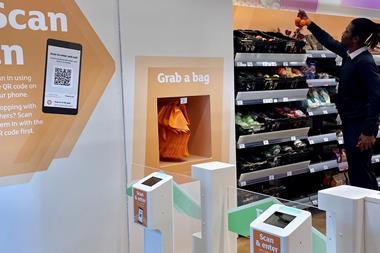The rise of non food is catching on. Fiona McLelland reports
Tesco, Asda and Sainsbury have developed a sophisticated non food offering to rival the best on the high street. They have long shaken off the inferior image of supermarkets’ clothing, electrical and homeware offerings and are enticing more consumers with the value and convenience of an ever-increasing non food range alongside grocery. Now, smaller retailers are keen to exploit the category to build footfall, margins and profits.
Somerfield recently announced it was to accelerate the roll-out of its in-store clothing and homeware range. Following an ongoing small trial with high street value chain Peacocks, it is to increase the number of shops offering the concession by 60% over the next six months to 32 stores. Somerfield’s tie-in with German retailer Tchibo to sell themed non food items has also undergone a big expansion over the past year, with 200 stores now offering the range.
“Customers expect to be able to buy more than just their basic groceries,” says a spokeswoman for Somerfield. “Where we are able to provide a non food option is a real asset as our customers can get additional items at a convenience. We will not put the range in a store that is situated between a specialist kitchenware and clothes store, but in areas where customers don’t have access to that offer, we can provide that something extra without them having to go out of town.” Research by Harris Interactive this summer showed some smaller retailers could do more to capitalise on the willingness of shoppers to buy non food from grocery stores. It showed The Co-operative Group’s customers were happy to buy more non food.
Brendan Thomas, category marketing manager for non food in The
Co-op’s food group, says the category is a key driver within the business. He says it generates incremental sales, improves footfall and increases average basket spend.
A comprehensive review of the entire non food range has taken place and electrical, cookshop and seasonal products have been flagged up as important lines for the future.
“We recognise the importance of the category within food retail and have tailored ranges as appropriate as well as significantly increasing promotional activity,” says Thomas. “We adopt similar category management principles and processes in non food as we do in our fresh and ambient sections when considering range changes and updates.”
Thomas and his team are concentrating on own label products as well as developing the non food range to create closer, stronger links between seasonal events and products.
Independent grocers can get in on the act too, says Ian Proudfoot, joint managing director at Proudfoot Group. “Non food can now be sourced very competitively against the large multiples. Even when we offer these products at such good prices, you can still expect a very healthy gross margin.”
Proudfoot travelled to China two years ago and discovered an array of non food goods. All six of his supermarkets have a non food range; the recently revamped Scarborough store has a whole floor dedicated to the category. He now uses importers in Manchester to source his non food from China at competitive rates.
“We give customers excellent value and keep a healthy gross margin.We’re in a good position to move into non food as our food creates a very regular and large footfall. If you can expand your range by adding 1,000 non food lines at a discount price - still retaining good margins - people will buy them.”
Tesco, Asda and Sainsbury have developed a sophisticated non food offering to rival the best on the high street. They have long shaken off the inferior image of supermarkets’ clothing, electrical and homeware offerings and are enticing more consumers with the value and convenience of an ever-increasing non food range alongside grocery. Now, smaller retailers are keen to exploit the category to build footfall, margins and profits.
Somerfield recently announced it was to accelerate the roll-out of its in-store clothing and homeware range. Following an ongoing small trial with high street value chain Peacocks, it is to increase the number of shops offering the concession by 60% over the next six months to 32 stores. Somerfield’s tie-in with German retailer Tchibo to sell themed non food items has also undergone a big expansion over the past year, with 200 stores now offering the range.
“Customers expect to be able to buy more than just their basic groceries,” says a spokeswoman for Somerfield. “Where we are able to provide a non food option is a real asset as our customers can get additional items at a convenience. We will not put the range in a store that is situated between a specialist kitchenware and clothes store, but in areas where customers don’t have access to that offer, we can provide that something extra without them having to go out of town.” Research by Harris Interactive this summer showed some smaller retailers could do more to capitalise on the willingness of shoppers to buy non food from grocery stores. It showed The Co-operative Group’s customers were happy to buy more non food.
Brendan Thomas, category marketing manager for non food in The
Co-op’s food group, says the category is a key driver within the business. He says it generates incremental sales, improves footfall and increases average basket spend.
A comprehensive review of the entire non food range has taken place and electrical, cookshop and seasonal products have been flagged up as important lines for the future.
“We recognise the importance of the category within food retail and have tailored ranges as appropriate as well as significantly increasing promotional activity,” says Thomas. “We adopt similar category management principles and processes in non food as we do in our fresh and ambient sections when considering range changes and updates.”
Thomas and his team are concentrating on own label products as well as developing the non food range to create closer, stronger links between seasonal events and products.
Independent grocers can get in on the act too, says Ian Proudfoot, joint managing director at Proudfoot Group. “Non food can now be sourced very competitively against the large multiples. Even when we offer these products at such good prices, you can still expect a very healthy gross margin.”
Proudfoot travelled to China two years ago and discovered an array of non food goods. All six of his supermarkets have a non food range; the recently revamped Scarborough store has a whole floor dedicated to the category. He now uses importers in Manchester to source his non food from China at competitive rates.
“We give customers excellent value and keep a healthy gross margin.We’re in a good position to move into non food as our food creates a very regular and large footfall. If you can expand your range by adding 1,000 non food lines at a discount price - still retaining good margins - people will buy them.”



















No comments yet